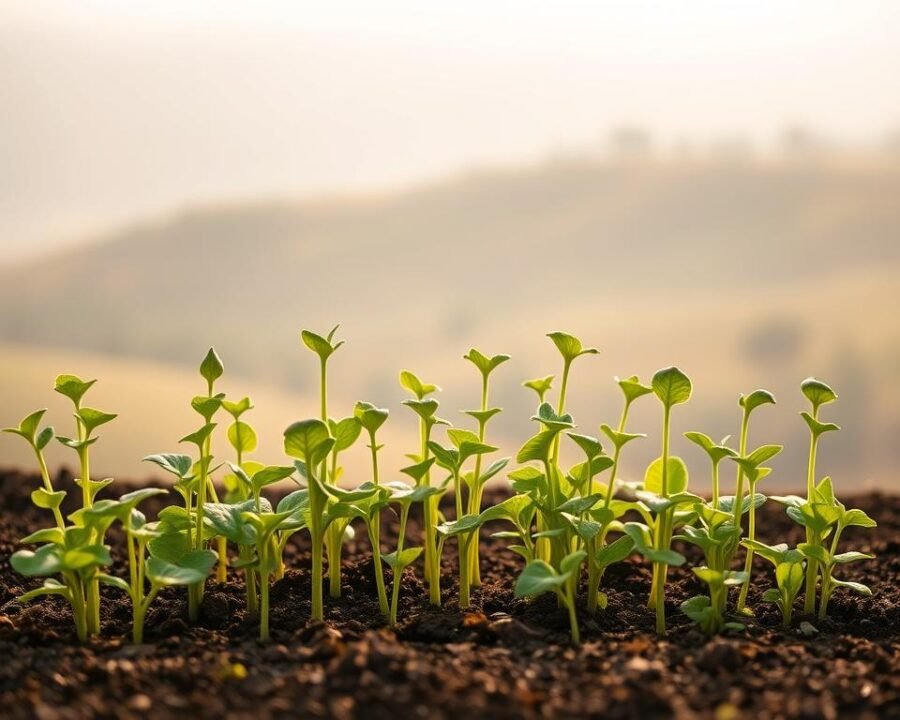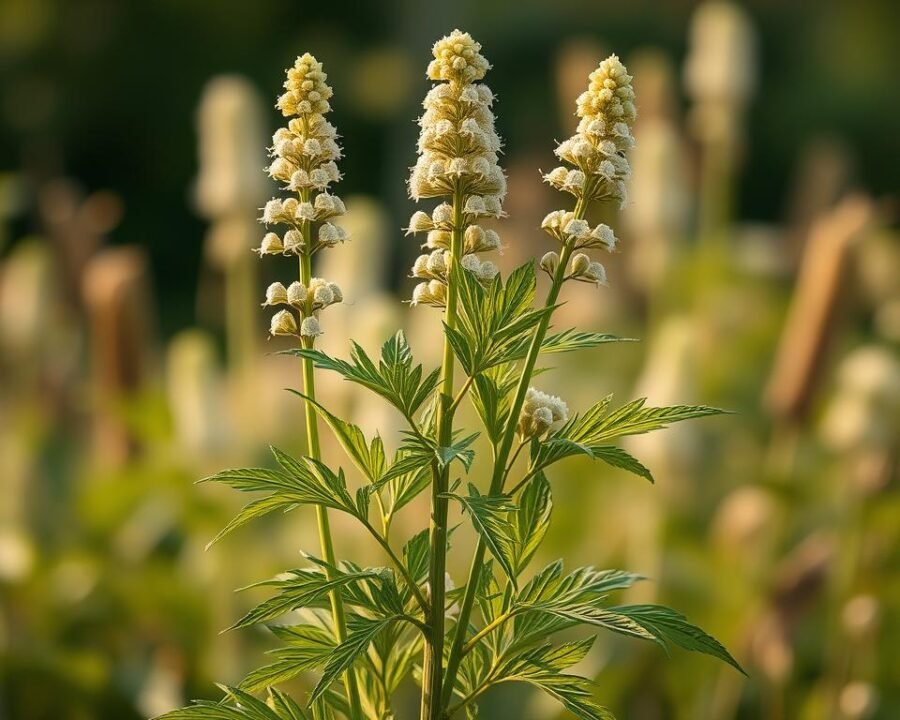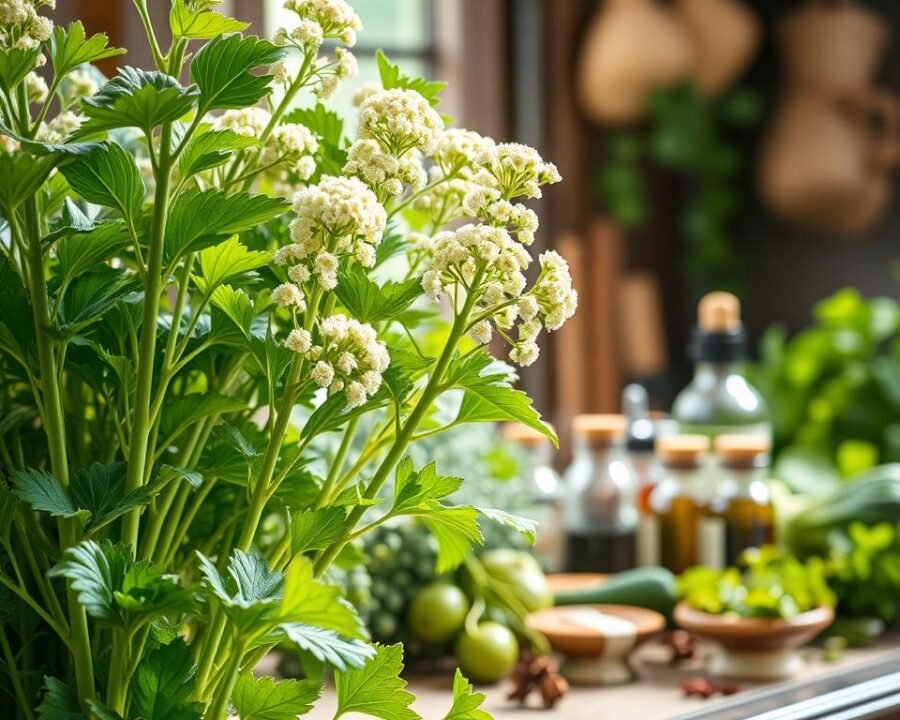Our Guide on How to Grow Angelica Herb Plant Everyone Is Using
There’s something magical about tending to a garden. The earthy scent of soil, the satisfaction of nurturing life—it’s a joy many of us share. If you’re looking for a standout addition to your green space, angelica might be the perfect choice. This towering herb isn’t just visually striking; it’s packed with flavor and history.
With its licorice-like taste and medicinal benefits, this plant has been cherished for centuries. Whether you’re a seasoned gardener or just starting, cultivating it can be rewarding. Partnering with experts like Strawbery Banke Museum and UNH Extension, we’ve gathered the best tips to help you succeed.
Angelica thrives in moist soil and partial shade, making it adaptable to many gardens. Its biennial cycle means patience pays off—but once established, it generously self-seeds. From propagation to harvest, we’ll walk you through each step.
Key Takeaways
- Angelica offers both culinary and medicinal benefits.
- This herb can reach an impressive height of 3-7 feet.
- It prefers moist soil and partial shade for optimal growth.
- The plant follows a biennial cycle and often self-seeds.
- Harvest young stems in spring for the best flavor.
Introduction to Growing Angelica
Tall, aromatic, and steeped in history—angelica commands attention. For over 400 years, this stately herb has flavored dishes and healed ailments. Its journey spans from medieval monasteries to Strawbery Banke’s heritage garden programs.
Today, chefs and bartenders treasure its licorice-like stems. You’ll find it elevating gin infusions or gourmet desserts. Yet its roots run deeper—literally. As an Apiaceae family member, it shares ties with carrots and parsley.
This biennial reaches 3–6 feet by its second year, thriving in moist soil. But caution: it resembles toxic cousins like hemlock. Proper identification ensures safety while harnessing its benefits.
“Angelica’s versatility—from apothecary jars to cocktail shakers—makes it a garden essential.”
Whether you’re drawn to its history or culinary potential, this herb rewards patience. Its towering presence and rich legacy make every harvest meaningful.
Why Angelica Is the Herb Everyone’s Growing
Gardens across New Hampshire are embracing a towering favorite. Angelica archangelica isn’t just another pretty face—it’s a powerhouse with dual talents. Schools in the NH School & Youth Garden Network showcase its appeal, blending beauty and utility seamlessly.
This stately plant solves common gardening challenges with ease. Struggling with soggy spots? Its love for moist soil turns problem areas into lush displays. Better yet, those umbrella-like flowers attract bees and butterflies by the dozen.
- Double duty: Acts as a dramatic backdrop in herb gardens while offering edible stems and leaves.
- Wildlife ally: 6-inch flower clusters are pollinator magnets, supporting local ecosystems.
- Low maintenance: Deer steer clear, and its self-seeding habit means fewer replanting chores.
Whether you’re designing a cottage garden or a functional plot, this biennial delivers. Its resilience and charm make it a standout choice for modern and heritage landscapes alike.
Ideal Growing Conditions for Angelica
Creating the ideal home for angelica ensures lush growth and abundant harvests. This stately plant flourishes under specific sunlight, soil, and climate conditions. Let’s break down each factor for success.
Sunlight: Full Sun to Partial Shade
Angelica adapts well to varied light. In cooler regions like New Hampshire, it enjoys full sun. Warmer zones benefit from afternoon shade to prevent leaf scorch.
Soil: Moist, Rich, and Slightly Acidic
This plant craves damp, fertile ground. Amend clay soils with compost for better drainage. A pH of 5.5–7.0 mimics its native Scandinavian habitat—test kits help monitor acidity.
Climate: Thrives in Cooler Zones (4–7)
Angelica overwinters effortlessly in frost-prone areas. Established specimens tolerate temperatures as low as -20°F. For warmer zones, strategic shading and extra watering bridge the gap.
| Zone | Adaptation Strategy | Key Consideration |
|---|---|---|
| 4–7 | Natural frost tolerance | Mulch roots in winter |
| 8–9 | Partial shade + misting | Prevent midday heat stress |
Pro Tip: In hot summers, mulch retains soil moisture. Angelica’s deep roots draw nutrients efficiently, reducing fertilizer needs.
How to Grow Angelica Herb Plant Everyone Is Using
The journey from tiny seeds to towering plants begins with smart preparation. Success hinges on two phases: germination and transplanting. Each step ensures robust growth for this biennial standout.

Starting from Seeds: Stratification Tips
Sow seeds in early spring after a cold stratification period. Mimic winter by chilling them in damp sand for 2–4 weeks. This breaks dormancy, boosting germination rates.
Use peat pots to protect young plant roots during early growth. These biodegradable containers prevent transplant shock. Keep soil moist but not waterlogged—angelica thrives in consistent dampness.
Transplanting Seedlings for Success
Move seedlings when they reach 3–4 inches tall, before taproots form. Space them 12 inches apart to allow mature spread. Follow this hardening-off routine:
- Day 1–3: Place outdoors in shade for 2 hours.
- Day 4–6: Increase to 4 hours with morning sun.
- Day 7: Full outdoor exposure.
| Stage | Timing | Key Action |
|---|---|---|
| Seed Sowing | Early spring | Cold-stratify seeds |
| Transplant | 3–4″ height | Use peat pots |
| Post-Transplant | First 2 weeks | Water deeply every 3 days |
After transplanting, maintain even soil moisture. A diluted seaweed tonic helps roots establish faster. Watch for new leaf growth—it signals successful adaptation.
Planting Angelica Step-by-Step
Mastering the art of planting angelica starts with perfect timing and technique. This biennial thrives when given the right foundation—proper spacing, depth, and seasonal care. Follow these steps to ensure vigorous growth from the start.
Spacing and Depth Requirements
Angelica’s towering stature demands room to spread. Space seedlings 18–24 inches apart to allow mature growth. Plant seeds at a depth of ¼ inch—any deeper may hinder germination.
- Soil prep: Mix in 2 inches of compost for nutrient-rich beds.
- Root care: Avoid disturbing *taproots* during transplanting.
- Succession planting: Stagger sowings every 2 weeks for continuous harvests.
Best Time to Plant
Early spring is ideal, once soil reaches 50–60°F. In New Hampshire, aim for April–May. Use cloches to protect young sprouts from late frosts.
| Method | Timing | Tips |
|---|---|---|
| Direct sow | April–May | Cover with row fabric if temps drop below 40°F |
| Transplants | After last frost | Harden off seedlings for 7 days |
“Angelica’s first year is all about roots—give it space, and year two will reward you with towering blooms.”
For colder zones, mulch heavily after planting. Warmer regions should prioritize partial shade to reduce heat stress. Consistent moisture is key—water deeply at planting time.
Angelica Care Guide
A thriving angelica plant starts with proper care techniques. While low-maintenance compared to many herbs, it responds dramatically to consistent attention. We’ll explore watering routines, feeding schedules, and organic pest solutions.

Watering: Keeping Soil Consistently Moist
Angelica craves damp soil but despises soggy roots. Check moisture by inserting a finger 2 inches deep—water when dry. Morning irrigation prevents fungal issues.
In hot spells, mulch with straw to retain hydration. Container-grown specimens need daily checks. Wilting leaves often signal thirst.
Fertilizing: Minimal Needs
This hardy biennial rarely requires synthetic feeds. Instead, top-dress with compost in early spring. For poor soils, a monthly seaweed tea boosts growth.
Over-fertilization causes leggy stems. If leaves yellow, try a nitrogen-rich fish emulsion.
“Companion planting solves 80% of pest problems before they start.”
Managing Pests and Diseases
Angelica occasionally battles aphids and leaf spot disease. Neem oil sprays deter insects without harming pollinators. For fungal issues:
- Remove affected leaves immediately
- Apply copper fungicide weekly
- Improve air circulation
| Companion Plants | Benefits |
|---|---|
| Chamomile | Deters flying pests |
| Nasturtiums | Traps aphids |
| Garlic | Prevents fungal spores |
Rotate planting locations every 3 years to disrupt pest cycles. Sterilize tools after handling infected plants to prevent spread.
Harvesting Angelica for Maximum Flavor
Timing is everything when harvesting angelica for peak flavor and potency. Different plant parts reach their prime at various stages, requiring careful observation.
When to Harvest Leaves and Stalks
Young leaves offer the best flavor in early spring. For candying or teas, pick them before flowers appear. Stalks become tender and sweet when harvested at 12-18 inches tall.
Follow this simple process for optimal results:
- Use clean, sharp scissors for cutting
- Harvest in morning after dew evaporates
- Leave at least 1/3 of foliage for plant health
Collecting Seeds in Late Summer
Seed heads ripen in late summer to early fall. Watch for browning flower clusters, then follow these preservation steps:
- Cut entire seed heads into paper bags
- Hang upside down in dry, dark location
- Winnow by gently rubbing heads over mesh
Properly stored seeds remain viable for 2-3 years. Keep them in glass jars with silica packs to maintain quality. This ensures future planting success.
“Harvesting at peak ripeness captures angelica’s complex essential oils at their most potent.”
Whether using fresh or preserving for later, these techniques guarantee the best results from your harvest.
Culinary and Medicinal Uses of Angelica
From Scandinavian kitchens to modern apothecaries, this herb delivers. Its stems, leaves, and roots each offer unique flavors and healing properties. Whether candied or brewed, angelica elevates both meals and remedies.

In Nordic traditions, young stems star in fish dishes. Their licorice-like zest cuts through rich flavors. Leaves add a fresh bite to salads, while dried roots make earthy teas.
For creative mixologists, angelica shines in spirits. Try this simple infusion:
- Chop 1 cup fresh stems
- Steep in vodka for 2 weeks
- Strain and sweeten with honey
“Angelica’s anti-inflammatory properties make it a go-to for joint poultices.”
| Culinary Uses | Medicinal Benefits |
|---|---|
| Candied stems for desserts | Root tea aids digestion |
| Leaves in herbal butter | Poultices soothe arthritis |
| Seeds for baking spice | Essential oils reduce stress |
This versatile herb bridges gardening and wellness. Whether flavoring gin or easing aches, it’s a garden powerhouse.
Common Challenges and Solutions
Even the hardiest plants face challenges, and angelica is no exception. While generally resilient, two issues occasionally trouble gardeners: pest invasions and root problems. With proactive care, these hurdles become manageable.
Stopping Aphids Before They Spread
Tiny green aphids sometimes cluster on new growth. They weaken plants by sucking sap and spreading disease. Try these organic solutions:
- Blast them off with a strong water spray in early morning
- Apply diluted neem oil every 5-7 days
- Introduce ladybugs—they devour 50+ aphids daily
Prevention works best. Mycorrhizal inoculants strengthen roots, making plants less appealing to pests. ‘Ebony’ cultivars show particular resistance.
Keeping Roots Healthy in Damp Conditions
Angelica loves moisture but suffers in stagnant soil. Root rot appears as wilting leaves and blackened roots. These strategies help:
| Solution | Implementation | Effectiveness |
|---|---|---|
| Raised beds | 8-12″ height with gravel base | 90% improvement |
| Drainage layer | 2″ sand beneath topsoil | Prevents pooling |
| Compost mix | 30% perlite amendment | Enhances aeration |
“Healthy soil means healthy plants—invest time below ground for spectacular results above.”
For existing rot, trim affected roots and replant in fresh mix. Reduce watering until new growth appears. Most plants recover with prompt action.
Conclusion: Start Growing Angelica Today
Few plants blend beauty and function as gracefully as this versatile biennial. Its herb garden appeal lies in dual rewards—towering blooms and kitchen-ready stems.
We encourage joining local seed exchanges. Programs like UNH Extension’s offer rare varieties perfect for cooler climates.
Pro tip: Stagger plantings every 3 weeks for continuous harvests. This gardening hack ensures fresh stems all season.
Share your success! Tag #AngelicaHarvest to inspire fellow growers. For deeper learning, explore master gardener workshops near you.
Ready to grow angelica? With minimal effort, this stately plant becomes a garden standout.







